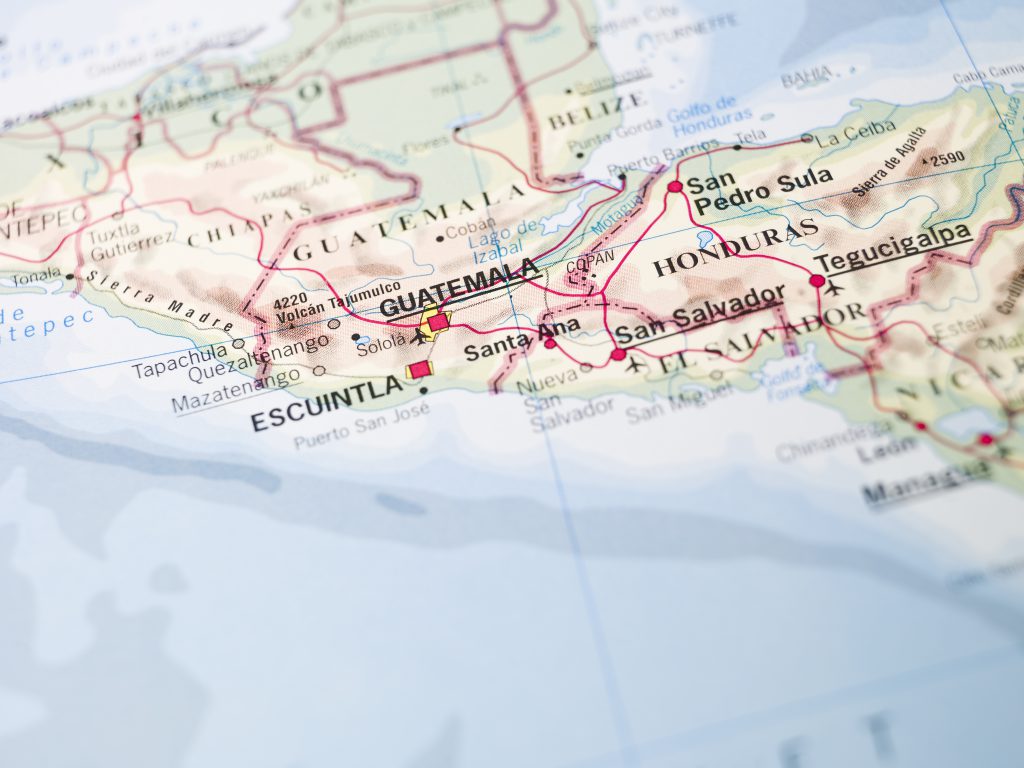Armed violence is a complex multidimensional phenomenon linked to high levels of inequality and exclusion, as well as institutional and structural constraints such as poor governance, weak rule of law, ineffective implementation of security strategies and high levels of impunity (UNICEF, 2020).
This article will show the consequences armed violence has on children’s life, survival and development (Humanium, 2020), and the effective methods that states can adopt in order to protect children from exposure to such violence.
Armed Violence in the Northern Triangle Countries
To better understand the complexity of the issue, we must first identify what armed violence is and which countries are experiencing high levels of such violence. Armed violence is not confined to war, it occurs increasingly in non-conflict settings including in middle-income countries and has a dramatic impact on children, their families and their communities. Armed violence results in forced displacement of families and severely affects the household livelihood and income (UNICEF, 2011).
The Northern Triangle countries are El Salvador (Humanium, 2020), Guatemala (Humanium, 2020) and Honduras (Humanium, 2020); they rank in the top ten worldwide for homicide, corruption, drug trafficking and gang violence. Non-state armed actors such as cartels or criminal organizations have influence in their communities which allows them to perpetuate insecurity by forcibly recruiting individuals into their ranks and using sexual violence as a tool of intimidation and control (United States Institute of Peace, 2018).

More than 15% of homicide victims globally are young males aged 15-29 from the Americas, with Honduras, El Salvador and Guatemala having the highest homicide rates in 2011 (UNICEF, 2020). Moreover, children face danger since traditional safe spaces such as their home, church and school no longer shield them from these types of risks.
In the Northern Triangle, it is still not clear the impact the cartels or “maras” (Moser & Winton, 2002) have on concrete social groups. Children, for example, are often subjects of exploitation. They become members of cartels because they will receive lower sentences carrying out illegal activities, if they are caught. They are used for prostitution and trafficking, they are often kidnapped and ransom is demanded from the families. The exploitation increases with migrant children. This has been a new phenomenon since 2014 which has yet to be solved.
Children and families are not just seeking refuge across borders as evidenced by the number of internally displaced persons (IDPs) in the region. According to the Internal Displacement Monitoring Centre, an estimated number of 714,000 people from the Northern Triangle were internally displaced as a result of conflict and violence as of the end of 2015 (Beltran, 2017).
Other societal factors can also influence whether violence is encouraged or inhibited. These include economic and social policies that maintain socioeconomic inequalities between people, the availability of weapons, and social and cultural norms such as those around male dominance over women, parental dominance over children and cultural norms that endorse violence as an acceptable method to resolve conflicts.
Consequences of Armed Violence on Children
Children are affected by armed violence in several ways:
- The effects of armed violence on children are both direct and indirect.
- The direct effects of combat on child health may include injury, illness, psychological trauma and death (Kadir, Shenoda, & Goldhagen, 2019).
- The effects on the physical, mental, developmental and behavioural health of children are profound with all organ systems in the developing child affected as a result of direct injury (Shenoda, Kadir, Pitterman, & Goldhagen, 2018).
- The death or injury of a caregiver changes a child’s life considerably and may force them to take on responsibilities that interfere with their education.
- Indirect effects relate to the destruction of infrastructure required by children for their optimal survival and development, environmental exposures such as birth defects and other downstream efforts on social determinants of health such as inadequate living conditions (Shenoda, Kadir, Pitterman, & Goldhagen, 2018).
- Traditionally safe spaces for children such as schools, hospitals, churches and play areas are increasingly affected by armed groups as a result of indiscriminate crossfire, looting or direct targeting. The results are disruptions in schooling and impaired economic growth and development (Shenoda, Kadir, Pitterman, & Goldhagen, 2018).
- Besieged populations or those whose farms and fields have been destroyed are vulnerable to acute and chronic malnutrition with subsequent effects on growth, immune and metabolic systems, as well as functioning and cognitive development (Shenoda, Kadir, Pitterman, & Goldhagen, 2018).
- Although violence against children is defined by violence against all persons aged under 18 years, the effects of violence do not end at the end of childhood, but continue into adulthood.
Addressing the Problem of Armed Violence
“It is unforgivable that children are assaulted, violated, murdered and yet our conscience is not revolted nor our sense of dignity challenged. This represents a fundamental crisis of our civilization.”
Machel, 2013
This statement is telling but an unfortunate reality for the children who live in conflict-affected areas. The magnitude of the problem requires an approach which ensures protection, education and psychological support for children (Silva, 2016); a children’s-rights based approach which addresses the impact of armed violence on youth in the region and aims at preventing and responding to violence.
A socio-ecological model for understanding violence against children and adolescents has proven to be an effective approach. It is a framework based on evidence that no single factor can explain why some people or groups are at higher risk of interpersonal violence, while others are more protected from it (Violence Prevention Alliance, 2020). This framework views interpersonal violence as the outcome of interaction among many factors at four levels: the individual, the relationship, the community and the society.
- At the individual level, personal history and biological factors influence how individuals behave and increase their likelihood of becoming a victim or perpetrator of violence. Among these factors are being a victim of child maltreatment, psychological or personality disorders, alcohol and/or substance abuse and a history of behaving aggressively or having experienced abuse (Violence Prevention Alliance, 2020).
- Personal relationships context examines how close relationships such as family, friends, intimate partners and peers may influence the risks of becoming a victim or perpetrator of violence. For example, having violent friends may influence whether a young person engages in or becomes a victim of violence (Violence Prevention Alliance, 2020).
- Community level contexts in which social relationships occur, such as schools, neighbourhoods and workplaces, also influence violence. Risk factors here may include the level of unemployment, population density, mobility and the existence of a local drug or gun trade (Violence Prevention Alliance, 2020).
- Societal factors influence whether violence is encouraged or inhibited. These include economic and social policies that maintain socioeconomic inequalities between people, the availability of weapons, and social and cultural norms such as those around male dominance over women, parental dominance over children and cultural norms that endorse violence as an acceptable method to resolve conflicts (Violence Prevention Alliance, 2020).
Socio-ecological model offers a framework for program planners to determine how to focus prevention activities. In order to prevent violence, it is important to implement programs and policies that can reduce risk factors and increase protective factors at each of the different levels in the model. Moreover, socio-ecological model provides the foundation to help children; however, more work must be done, particularly for the children in the Northern Triangle.
What Are Potential Solutions?
As stated earlier, armed violence against children is a complex issue which requires a carefully tailored approach in order to be solved. The children in the Northern Triangle countries need special protection and the community must be supported in order to ensure that they are able enjoy a life without violence. There are various ways this can be achieved:
- Children associated with armed groups and armed forces should receive the necessary support to be reintegrated into their communities (UNHCR, 2020).
- Children, adolescents and youth can rebuild their lives through psychosocial support and recreational activities and education (UNHCR, 2020).
- Conducting evidence-based, community-level programs can reduce crime and violence and protect children who have suffered from violence. Evidence suggests that investing in prevention initiatives that bring together local groups, churches, police, social services and government agencies can make a difference in reducing youth violence and victimization (Beltran, 2017).
- Support from UNHCR, UNICEF, local communities and civil societies in assisting robust programs can enhance transparency and accountability and address the deep-seated corruption that hinders citizens’ access to basic services, weakens state institutions and erodes the foundations of democracy (Beltran, 2017).
Creating a safe and supportive environment for children ensures that they are able to develop and enjoy their childhood without any disruptions from armed violence. Children exposed to armed violence are robbed of their childhood and suffer from chronic issues which can affect their adulthood. We must urge governments and all international organisations, especially those of the Northern Triangle, to address this issue and ensure that no child is left behind.

At Humanium we seek to raise awareness of the importance of children’s rights to life, survival, development (Humanium, 2020) and protection (Humanium, 2020). Join us in making children’s rights to a safe environment a reality by sponsoring a child, making a donation or becoming a volunteer!
Written by Igi Nderi
References:
Humanium. (2020, July 28). Children of El Salvador. Opgehaald van Humanium.
Humanium. (2020, July 28). Children of Guatemala. Opgehaald van Humanium.
Humanium. (2020, July 28). Children of Honduras. Opgehaald van Humanium.
Humanium. (2020, July 28). RIght to Life. Opgehaald van Humanium.
Humanium. (2020, July 31). Right to Protection. Opgehaald van Humanium.
Kadir, A., Shenoda, S., & Goldhagen, J. (2019). Effects of armed conflict on child health and development: A systematic review. PLOS ONE, 1.
Shenoda, S., Kadir, A., Pitterman, S., & Goldhagen, J. (2018). The Effects of Armed Conflict on Children. American Academy of Pediatrics, 2.
UNHCR. (2020, July 31). Children and Youth Protection. Opgehaald van UNHCR.


